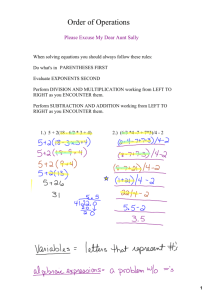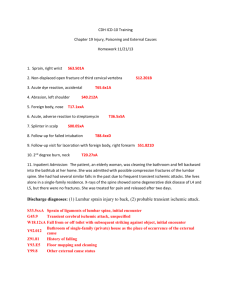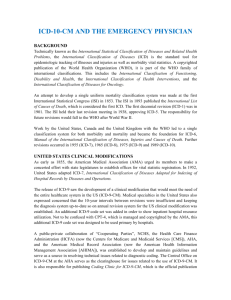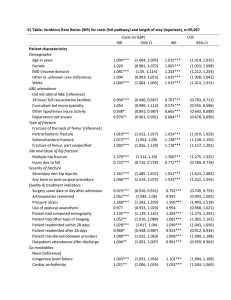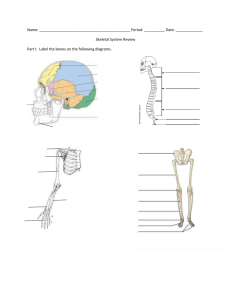Overview of ICD-10-CM
advertisement
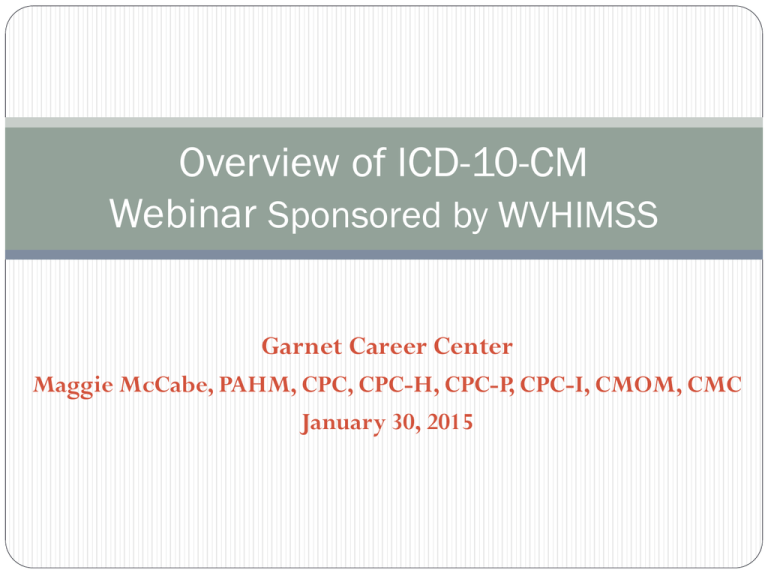
Overview of ICD-10-CM Webinar Sponsored by WVHIMSS Garnet Career Center Maggie McCabe, PAHM, CPC, CPC-H, CPC-P, CPC-I, CMOM, CMC January 30, 2015 Disclaimer The information contained in this document should not be construed as legal representation. It is current as of October 1, 2014. All information is from the extensive training and interpretation of the presenter. Garnet Career Center and Maggie McCabe retain ownership of the information contained herein. No part of this presentation may be reproduced or transmitted in any form or by any means without the express permission of Maggie McCabe. Why this Change? Very simply, ICD-9-CM is running out of codes Increased specificity Provide the medical necessity for services that are currently being rendered For the betterment of healthcare Because the government says so (tongue in cheek) No delays No grace period for using ICD-9-CM The ICD Manual ICD-9-CM Volume 1--Tabular Volume 2--Index ICD-9-PCS Volume 3 ICD-10-CM Alphabetic Index Tabular What is the Effective Date Now? October 1, 2015 ICD-9-CM ends September 30, 2015 Will there be another delay? Federal Rule August 4, 2014 This final rule establishes October 1, 2015 as the compliance date for ICD–10. It also requires the continued use of ICD–9–CM through September 30, 2015. Who Does This Change Effect? Those covered by HIPAA Small, medium and large practices Clinics Hospitals, SNFs, FQHC Payers Clearing Houses All staff Patients Training? Who When Why Similarities Several Conventions NEC/NOS Punctuation Includes Notes Borderline Diagnosis If the provider documents a "borderline" diagnosis at the time of discharge, the diagnosis is coded as confirmed, unless the classification provides a specific entry (e.g., borderline diabetes). If a borderline condition has a specific index entry in ICD-10-CM, it should be coded as such. Since borderline conditions are not uncertain diagnoses, no distinction is made between the care setting (inpatient versus outpatient). Whenever the documentation is unclear regarding a borderline condition, coders are encouraged to query for clarification. Chapters and Such ICD-9-CM had 17 Chapters along with V-codes and E-codes ICD-10-CM has 21 chapters including the equivalent of the V and E Codes Titles may change slightly Order of chapters may vary Some diagnoses have been moved to other chapters to be more consistent Streptococcal Sore Throat ICD-9-CM was listed with Infectious Diseases ICD-10-CM has been moved to Respiratory System 2 New Chapters Eye and Adnexa Ear and Mastoid Process Chapter & I-10 Range ICD-9CM ICD-10-CM 1 (A00-B99) Infectious & Parasitic Disease Certain Infections & Parasitic Diseases 2 (C00-D49) Neoplasms Neoplasms 3 (D50-D89) Endocrine, Nutritional & Metabolic Diseases, & Immunity Disorders Diseases of the Blood & Blood forming Organs & Certain Disorders Involving the Immune Mechanism 4 (E00-E90) Diseases of the Blood and Blood Forming Organs Endocrine, Nutritional & Metabolic Diseases 5 (F01-F99) Mental Disorders Mental, Behavioral & Neurodevelopmental Disorders 6 (G00-G99) Diseases of the Nervous System and Sense Organs Diseases of the Nervous System 7 (H00-H59) Diseases of the Circulatory System Diseases of the Eye and Adnexa 8 (H60-H95) Diseases of the Respiratory System Diseases of the Ear & Mastoid Process 9 (I00-I99) Diseases of the Digestive System Diseases of the Circulatory System 10 (J00-J99) Diseases of the Genitourinary System Diseases of the Respiratory System Chapter & I-10 Range ICD-9CM ICD-10-CM 11 (K00-K95) Complications of Pregnancy, Childbirth & the Peurperium Diseases of the Digestive System 12 (L00-L99) Diseases of the Skin & Subcutaneous Tissue Diseases of the Skin & Subcutaneous Tissue 13 (M00M99) Diseases of the musculoskeletal System & Connective Tissue Diseases of the musculoskeletal System & Connective Tissue 14 (N00-N99) Congenital Anomalies Diseases of the Genitourinary System 15 (O00O9A) Certain Conditions Originating in the Perinatal Period Pregnancy, Childbirth & the Puerperium 16 (P00-P96) Symptom, Signs & Ill-Defined Conditions Certain Conditions Originating in the Perinatal Period 17 (Q00-Q99) Injury and Poisoning Congenital Malformations, Deformations & Chromosal Abnormalities 18 (R00-R99) Symptoms, Signs & Abnormal Clinical & Laboratory Findings, Not Elsewhere Classified N/A Chapter & I10 Range ICD-9CM ICD-10-CM 19 (S00-T88) N/A Injury, Poisoning & Certain Other Consequences of External Causes 20 (V00-Y99) N/A External Causes of Morbidity 21 (Z00-Z99) N/A Factors Influencing Health Status & Contact with Health Services Supplementary Classification V-Codes Classification of Factors Influencing Health Status & Contact with Health Services N/A Supplementary Classification E-Codes Classification of External Cause of Injury & Poisoning Alphanumeric Every code begins with an Alpha character United States does not use “U” Alpha characters may appear in other positions Be Careful: “O” versus “0” OB/GYN codes “I” versus “1” Circulatory ICD-9-CM Digits Highest Level of Specificity Format 3rd digit = Category 4th digit = Sub-Category 5th digit = Sub-Classification ICD-10-CM Characters Highest Level of Specificity Format 3rd character = Category 4th character = Sub-Category 5th character = Sub-Category 6th character = Sub-Category 7th character = Sub-Category Four Character Categories Define Site Etiology Manifestation Five - Six Character Sub-Classification Either of these characters represent the most accurate level of specificity Related to patient’s condition or diagnosis Seventh Character Extension Must always be in the 7th character position Therefore Dummy placeholder of “X” may be needed in the 5th and/or 6th character Placeholder 7 character format Sometimes not all characters used Value of X is used in the 5th or 6th position Blanks or dashes are not acceptable Excludes Notes Excludes 1 AND Excludes 2 Locating a Code NEVER Code from the Index of ANY Code Manual ICD-9-CM Index –Volume 2 Tabular –Volume 1 ICD-10-CM Index Tabular Sequela Residual Effect Acute Encounter Laterality Right Left Bilateral Consistency with CPT Diabetes ICD-10-CM Combination Codes Type of diabetes mellitus Body system affected Complications affecting that body system Five Categories of Diabetes in ICD-10-CM E08 Diabetes mellitus due to an underlying condition E09 Drug or chemical induce diabetes mellitus E10 Type 1 diabetes mellitus E11 Type 2 diabetes mellitus E13 Other specified diabetes mellitus Eye Patient presents to the physician with acute serous conjunctivitis, non-viral, bilaterally ICD-CM-10 Code = Edema right orbit ICD-CM-10 Code = OB/GYN High risk pregnancy in ICD-9-CM was a V-code; now it is located in Chapter 15 with the other codes Guideline in ICD-CM-10: Pre-existing condition vs. condition related to the pregnancy Pre-existing hypertension in pregnancy Sepsis and Septic Shock Alcohol and tobacco use Poisoning, toxic effects, adverse effects and underdosing in a pregnant patient Pregnancy associated with cardiomyopathy 7th character for fetus identification Selection of trimester and weeks gestation Sprain, Lower Extremity Grade I – mild sprain, ligaments stretched but not torn Grade II – moderate sprain, ligaments are partially torn and there may be some loss of function Grade III – severe sprain, ligament is completely torn/ruptured Episode of care A Initial encounter D Subsequent encounter S Sequela Pathologic Fracture 7th character A is for use as long as the patient is receiving active treatment for the fracture. Examples of active treatment are: surgical treatment, emergency department encounter, evaluation and treatment by a new physician. 7th character, D is to be used for encounters after the patient has completed active treatment. The other 7th characters, listed under each subcategory in the Tabular List, are to be used for subsequent encounters for treatment of problems associated with the healing, such as malunions, nonunions, and sequelae. Fractures 7th Character Extension Example A = initial encounter for closed fracture B = initial encounter for open fracture D = subsequent encounter for fracture with routine healing G = subsequent encounter for fracture with delayed healing K = subsequent encounter for fracture with nonunion P = subsequent encounter for fracture with malunion S = sequela Traumatic Fractures Grade I The wound is less than 1cm long. It is usually a moderately clean puncture, through which a spike of bone has pierced the skin. There is little soft-tissue damage and no sign of crushing injury. The fracture is usually simple, transverse, or short oblique, with little commination. Grade II The laceration is more than 1 cm long, and there is no extensive soft-tissue damage, flap, or avulsion. There is slight or moderate crushing injury, moderate commination of the fracture, and moderate contamination. Grade III These are characterized by extensive damage to soft-tissues, including muscles, skin, and neurovascular structures, and a high degree of contamination. The fracture is often caused by high velocity trauma, resulting in a great deal of commination and instability. III A – Soft tissue coverage of the fractured bone is adequate III B – Extensive injury to, or loss of soft tissue, with periosteal stripping and exposure of bone, massive contamination, and severe commination of the fracture. After debridement and irrigation a local or free flap is needed for coverage. III C – Any open fracture that is associated with an arterial injury that must be repaired, regardless of the degree of soft tissue injury. The definitive grade should be assigned in theatre after thorough debridement. The risk of infection in an open fracture depends on the amount of contamination, severity of soft tissue injury, and operative treatment of the fracture Fracture of the Femur The appropriate 7th character is to be added to all codes from category S72 A = initial encounter for closed fracture B = initial encounter for open fracture type I or II C = initial encounter for open fracture type IIIA, IIIB, or IIIC D = subsequent encounter for closed fracture with routine healing E = subsequent encounter for open fracture type I or II with routine healing F = subsequent encounter for open fracture type IIIA, IIIB, or IIIC with routine healing G = subsequent encounter for closed fracture with delayed healing H = subsequent encounter for open fracture type I or II with delayed healing J = subsequent encounter for open fracture type IIIA, IIIB, or IIIC with delayed healing K = subsequent encounter for closed fracture with nonunion M = subsequent encounter for open fracture type I or II with nonunion N = subsequent encounter for open fracture type IIIA, IIIB, or IIIC with nonunion P = subsequent encounter for closed fracture with malunion Q = subsequent encounter for open fracture type I or II with malunion R = subsequent encounter for open fracture type IIIA, IIIB, or IIIC with malunion S = sequela Behavior Health Depressive Disorder No Chapter Specific Guidelines ICD-9-CM Pain disorders related to psychological factors Remission Psychoactive Substance Use, Abuse and Dependence If both use and abuse are documented, assign only the code for abuse If both abuse and dependence are documented, assign only the code for dependence If use, abuse and dependence are all documented, assign only the code for dependence If both use and dependence are documented, assign only the code for dependence Psychoactive Substance Abuse Circulatory Documentation AMI must be identified as initial or subsequent (occurring w/in 4 weeks (28 day) acute phase of the initial MI Atherosclerosis of the extremities now sub-divided into legs & other extremities Laterality required with embolism, thrombosis, varicose veins, etc Endocrine, Nutritional & Metabolic More specific information is required to code the type of congenital hypothyroidism; iodine deficiency thyroid disorders; parathyroid gland Secondary diabetes requires documentation related to whether the condition is due to an underlying condition or whether it is drug or chemical induced Cushing’s syndrome is not differentiated by type and cause Disorders related to hyperalimentation require documentation of the specific condition Metabolic disorders require greater detail related to the specific amino-acid, carbohydrate or lipid enzyme deficiency responsible for the disorder Documentation Suggestions “Not Documented, Didn’t Happen” Therefore Can’t Code It Can’t Bill It No Reimbursement True today, even truer tomorrow!!!!! Documentation Address the reason for the encounter or the problem Show an examination Tie it all together Assessment Plan Documentation Reduce Coder/Auditor Queries Be specific If it is a thought, document it Documentation Seven elements current documentation lacks Disease type is not indicated Exact details pertaining to disease are not mentioned Documentation missing in entirely Specific location (if relevant) is not identified Stages of diseases are missing documentation Right/left sides are not properly identified Documentation for combination codes is improperly documented to code accurately Neoplasm Require more specific documentation of the site of the malignancy Require laterality for the extremities Require stages for melanoma Stage I – localized Stage IA – less than 1.0 mm thick, no ulceration Stage IB – less than 1.0 mm thick, ulceration Continues through stage IV Follicular Lymphoma Several different types; some with a grading system Grade I – 0-5 centroblasts per hpf with a predominance of small centrocytes Grade II – 6-15 centroblasts per hpf with centrocytes present Grade III -- >15 centroblasts per hpf with decreased or no centroctyes still present Grade IIIA -- >15 ecntroblasts per hpf with centrocytes still present Grade IIIB -- >15 centroblasts per hpf presenting as solid sheets with no centrocytes present How Will Superbills Change? Current, CPT one side ICD-9 Flip side Future, CPT one side Many examples on Internet, especially with …. WEDI Survey Information Vendor product development – 40% of vendors indicate complete. Improvement over 2013 survey Vendor product availability – More than 25% responded their products would not be ready until2015 Health plan impact assessment – Nearly 75% completed their impact assessment Health plan testing – More 50% already begun external testing compared to 25% in prior survey Provider Impact Assessment – About 50% completed assessment Provider testing – About 35% have completed; in 2013 60% expected to begin in 2014 External testing approach – 60% providers expect to test with a sample or providers; 20% indicated they will test with a majority of providers In Summary When do we start – should have started 2-3 years ago What has to be done – internal/external audits; training; testing How do we do it – talk to your providers immediately; contact your vendor and health plans; test as much as possible It is very important to take the time now! References AAPC Professional Medical Coding Curriculum AAPC Licensed Instructor Curriculum AAPC ICD-10-CM Expert AAPC Coder References ICD-10-CM Coding Guidelines CMS Website Information Questions??? Thank you
